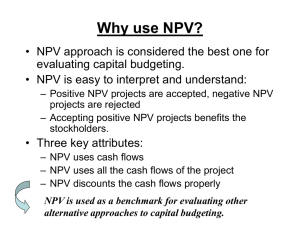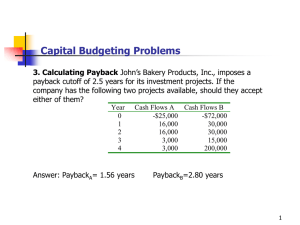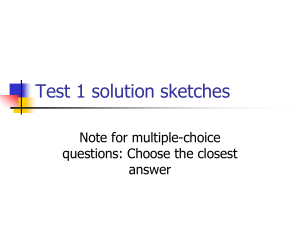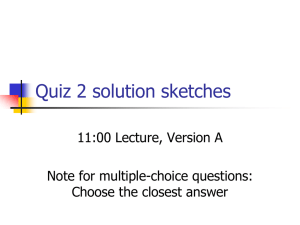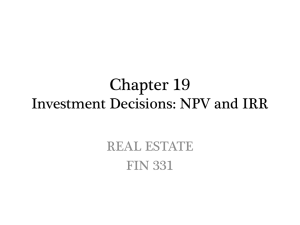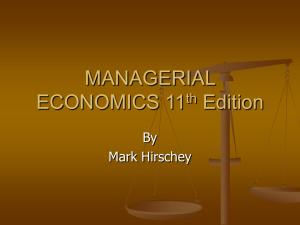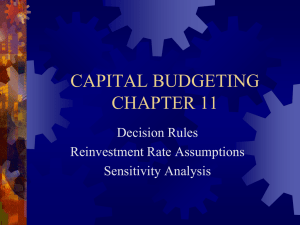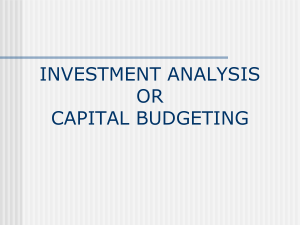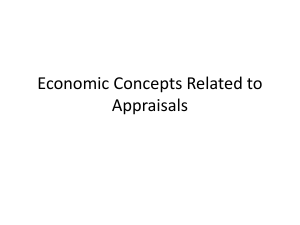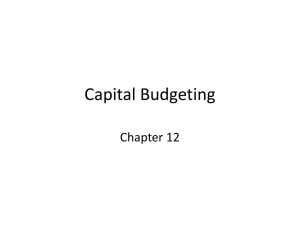Lecture in Energy Auditing
advertisement
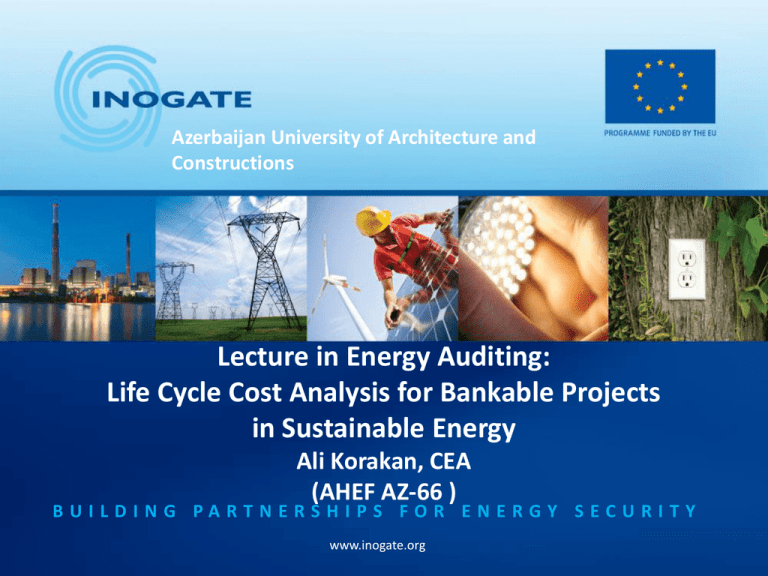
Azerbaijan University of Architecture and Constructions Lecture in Energy Auditing: Life Cycle Cost Analysis for Bankable Projects in Sustainable Energy Ali Korakan, CEA (AHEF AZ-66 ) BUILDING PARTNERSHIPS FOR ENERGY SECURITY www.inogate.org Lecture Learning Objectives • Learn basics of Life Cycle Cost (LCC) feasibility analysis • Learn structured methodology for performing LCC analysis to develop bankable energy efficiency and renewable energy projects • Learn Data collection and reality checks necessary for inputing to LCC analysis • Learn report writing techniques to convince investors of feasible projects • Case studies of economic analysis for energy efficiency/renewable energy projects. Energy Efficiency Projects • Energy conservation Any behavior that results in the use of less energy. • Energy efficiency The use of technology that requires less energy to perform the same function. Requires investment, hence financing. Energy Systems Energy is used in residential, comercial and industrial buildings, in industry and in transport • Power generation • Special purpose production & process equipment or systems • HVAC system – for production processes or personal comfort • Boiler and steam systems • • • • • • Hot water systems Electrical systems Lighting Compressed air systems Motors Transportation Sources of Energy • Non-renewable energy sources energy sourced that we use up and cannot recreate in a short period of time e.g., fosil fuels: coal, oil and gas • Renewable energy sources energy sourced that we can use over and over again, and can be replaced naturally in a short period of time e.g., solar, wind, geothermal, biomass, hydro, wave The Need for Economic Analysis • Economics play a dominant role in the decision whether the management/owner and the financing institutions will invest in an energy efficiency/renewable energy project or not. • The communication of engineers/energy managers with the decision makers is very important in investment decisions. The engineer/energy manager must learn to speak management’s language. • The engineer/energy manager must present projects in economic terms in order to help the top management/financiers to make their decisions. Project Profitability Analysis • Profitability analysis is a method used for assessing finacial feasibility of a project. • Life Cycle Cost Analysis (LCCA) is used for project profitability analysis because it takes into account the entire life of a project and time value of money. Life Cycle Cost Feasibility Analysis • LCCA is an engineering economic analysis tool used to calculate the financial feasibility of a project. • Considers all costs, revenues and savings incurred during the service life of the project from cradle to grave. • It compares the relative merits of competing project implementation alternatives. • Helps the decision maker to accept or reject a project and prioritise accepted projects. LCC Indicators NPV, SIR and IRR are LCC indicators which demonstrate the economic feasibility of a project. • Absolute project worth: NPV (Net Present Value) shows how much value will be generated during the life cycle of the project. It takes into account time value of money and shows the present (today’s) value of the project. Value generation can be from the savings in the case of energy efficiency projects or it can be from the revenues as in the case of the renewable energy projects. LCC indicators LCC indicators demonstrate the economic feasibility of a project. • Relative project worth: SIR (Savings-to-Investment Ratio) shows the value of the project relative to the investment. SIR considers time value of money both for the investment and net cash flow generated by the project. • Specific to project: IRR (Internal Rate of Return) shows the average annual return earned through the life cycle of the project. The term internal refers to the fact that it is independent of economic environmental factors. Discount rate has no effect on IRR. Time Value of Money Basic rule: Money you have today is worth more than in the future. • Future Value (FV) shows the value of money/project at a specific time in the future that is equivalent in value to a specified sum today. We use compounding to calculate FV. • Present Value (PV) shows how much future money/project is worth today. We use discounting to calculate PV. Future cash flows are discounted at the discount rate, and the higher the discount rate, the lower the present value of the future cash flows . LCCA Parameteres • Discount rate (i) - a rate at which the future benefit (loss) can be compared to the present value. Determining the appropriate discount rate is the key to properly valuing future cash flows. Discount rate is calculated by using the following parameters. – Risk free interest rate – Inflation – Risk premium • Analysis Period - the period of time over which LCCA is performed. • Residual Value – the value of the investment at the end of the analysis period. Time Value of Money Compounding: Suppose you put €100 in a saving account at 5% interest rate for 5 years. How much money you will have at the end of the period? Time Value of Money Compounding • • • • • Year 1: Year 2: Year 3: Year 4: Year 5: 5% of €100.00 = €5.00 + €100.00 = €105.00 5% of €105.00 = €5.25 + €105.00 = €110.25 5% of €110.25 = €5.51 + €110.25 = €115.76 5% of €115.76 = €5.79 + €115.76 = €121.55 5% of €121.55 = €6.08 + €121.55 = €127.63 130 Compounding FV (Net Value) 140 120 100 € 80 60 40 20 0 125 PV (Discounted Value) 120 € 115 FV = PV x (1+ i)n 110 105 100 0 1 2 3 Years 4 5 0 1 2 3 years 4 5 Time Value of Money Discounting: How much is a € 100 bill worth today compared to its value 1 year? The interest rate is 5%. Time Value of Money Discounting • • • • • • Year 0: Year 1: Year 2: Year 3: Year 4: Year 5: 5% of €100,00 = €100 / (1+0,05)0 = €100 5% of €100,00 = €100 / (1+0,05)1 = €95,24 5% of €100,00 = €100 / (1+0,05)2 = €90,70 5% of €100,00 = €100 / (1+0,05)3 = €86,38 5% of €100,00 = €100 / (1+0,05)4 = €82,27 5% of €100,00 = €100 / (1+0,05)5 = €78,35 PV FV = ───── (1+ i)n 100 Discounting 95 FV (Net Value) PV (Discounted Value) 90 100 € 80 € 60 85 80 40 75 20 0 0 0 1 2 3 Years 4 5 1 2 3 years 4 5 Net Present Value (NPV) NPV (Net Present Value) is calculated by discounted cash flow method. It is the difference of all discounted cash in (B – benefits) and all discounted cash out (C – Costs) • • • • • NPV – net present value B – benefits C – Costs i – interest rate t - period Internal Rate of Return (IRR) Theoretically IRR (Internal Rate of Return) is the value of discount rate that makes NPV zero. • • • • • • NPV – net present value B – benefits C – Costs i – interest rate t - period IRR – internal rate of return Simple Payback Period (SPB) • Simple Payback Period (SPB) – the length of time required to recover the cost of the investment. Cost of Project SPB = ───────────── Annual Cash Inflows • There are two drawbacks with the payback period – It ignores any benefits that occur after the payback period and therefore does not measure profitability – It ignores the time value of money Ten Steps for LCCA The discounted cash flow life cycle cost analysis methodology in 10 steps is used to calculate the financial feasibility of an energy efficiency or renewable energy project. The 10 step methodology utilizes a spreadsheet running on a computer to calculate the discounted cash flow in order to analyze the feasibility of a project. Ten Steps Ten Steps to determine Finacial Feasibility of an Energy Project. 1. Determine old costs (existing baseline conditions). 2. Determine new costs (implementation and beyond). 3. Calculate differences. 4. Choose discount rate. 5. Choose analysis period. 6. Estimate residual value of equipment at end of service life. 7. Calculate present value of annual savings. (PV) 8. Calculate present value of investments (PV). 9. Calculate net present value (NPV). 10. Calculate savings-to-investment ratio & internal rate of return (IRR). Step 1 Determine Old Costs (Baseline Conditions) a) b) c) d) Life cycle re-investments Annual energy costs Annual operations & maintenance (O&M) costs Other annual costs Good analysis begins with good definition of the existing situation. Definition considers the schedule of predicted costs of major non-annual replacements of the old technology, as well as annual energy costs, O&M costs and other current costs. Step 1a Life Cycle Re-investments Life cycle investments consist of capital required in year zero plus future irregular expenses, i.e., re-investment costs separate from annual O&M. They comprise only non-annual costs. The best source of information for re-investments is maintenance records. • Does existing equipment need an overhaul now (in year zero?) to continue in service? • If not, when? And how often? • How much money would have to be re-invested each time? Examples of re-investments • Overhauling a compressor every 5 years • Replacing lamps every 10,000 hours Step 1a Old Re-investment Table Year • Old equipment probably needs periodic re-investment to keep going. • Assume: Old re-investment costs = €50 000 every 4 years (from maintenance records) • Assume: Last replacement was two years ago, so next replacement is in year 2. • Enter data in "Old" column. Old 0 1 2 € 50,000 3 4 5 6 € 50,000 7 8 9 10 € 50,000 11 12 13 14 € 50,000 15 16 17 18 19 € 50,000 Step 1b Annual Energy Costs Old annual energy costs = Old annual energy * energy tariff Information source: - actual, paid bills - meter data multiplied by cost of energy Example: Old annual energy costs = €177,000/yr (from energy audit) Step 1c Annual Operations & Maintenance (O&M) Costs 1. Come from actual records of maintenance 2. Often data is lost, auditor is forced to estimate Example: • In this case, assume poor maintenance at low cost. • O&M = €2,500/yr. Step 1d Other Annual Costs • Penalties should be included in the analysis as a cost of operating the old equipment. • List other annual old costs that will be affected by the project, such as - productivity - penalties for pollution Step 2 Determine New Costs (Implementation and Beyond) a) Initial investment b) Life cycle re-investments c) Annual energy costs d) Annual operations & maintenance (O&M) costs e) Other annual costs Step 2a Initial Investment Initial investment = Basic project cost + engineering, supervision + profit + contingency + taxes + other For estimation purposes, add costs as %. Important to uncover all the initial costs Step 2a Initial Investment (cont.) Basic project cost = €78,000 Initial investment = Basic project cost + engineering + profit + contingency + taxes (from energy audit) = Basic project cost * (1 + 0.2 + 0.1 + 0.1 + 0.2) = €78,000 * 1.6 = €124,800 Enter data in year 0 of "New" column of investment table. Step 2b Life Cycle Re-investments Five year replacement costs = 25% of the initial investment (from manufacturer's recommendation) = 0.25 * €124,800 = €31,200 Enter data in years 1 to end of "New" column of investment table. Steps 2a and 2b New Investment and Re-investment 20th There is no year for reinvestment, even with 20 year analysis. Year 0 New € 124,800 1 2 3 Investments are considered to be made at the end of each year. 4 5 € 31,200 6 7 At the end of the last year of analysis, the project is over. 8 9 10 € 31,200 11 12 Further investment requires a new project with new analysis. 13 14 15 16 17 18 19 € 31,200 Step 2c Annual Energy Costs New annual energy costs = new annual energy * cost of energy Where to find: - the best available information from manufacturers - the most realistic operating assumptions Example: New annual energy costs = €132,000/yr energy audit) (from Step 2d Annual Operations & Maintenance (O&M) costs Operating costs must be estimated realistically Example: New O&M = €5000/yr (from manufacturer's recommendations) Step 2e Other Annual Costs List other annual new costs that will be improved by the project, such as - improved productivity - reduced penalties Step 3 Calculate Differences a) Life cycle investments b) Annual savings Step 3a Life Cycle Investments Year 0 • Investments and re-investments • Spreadsheet subtracts old costs from new costs • Net = new – old Old € 124,800 Net Amount € 124,800 €0 1 € 50,000 2 -€ 50,000 3 €0 4 €0 5 • Only non-annual costs New € 31,200 € 31,200 € 50,000 6 -€ 50,000 7 €0 8 €0 9 €0 10 € 31,200 € 50,000 -€ 18,800 11 €0 12 €0 13 14 €0 -€ 50,000 € 31,200 15 € 50,000 € 31,200 16 €0 17 €0 18 19 € 50,000 -€ 50,000 €0 Step 3b Annual Savings Annual cost savings = old energy cost - new energy cost + old O&M - new O&M + old other - new other ! Factors in annual savings may be negative, e.g.: • increased O&M from new, on-site cogeneration • rigorous new maintenance to replace lax old maintenance Step 3b Annual Savings • Example: • Annual cost savings • = €176,000 - €132,000 Annual Savings • + €2,500 - €5,000 Discount Rate Analysis period (years) • + €0 - €0 Residual value • = €41,500 • Enter in appropriate input cell. 500 €$41 41,500 Step 4 Choose Discount Rate The discount rate for an investment depends on the type of financing, equity or loan. • In the case of pure equity financing, the discount rate can be the return on the best possible interest rate from any other project. • In the case of a loan, the discount rate equals the loan interest rate. • If there is a mix of equity and loan, then the project's discount rate is the weighted average of these two separate rates. Annual Savings Choose a discount rate r = 12% 12% Discount Rate Enter discount rate in Analysis period (years) appropriate input cell. Residual value Step 5 Choose Analysis Period Only a short analysis period (e.g., 10 years) should be used in an unstable economic situation with high interest rates. Savings and expenses beyond 10 years become trivial due to heavy discounting. Choose analysis period T = 15 years. Annual Savings Discount Rate Enter analysis period in appropriate input cell. Analysis period (years) Residual value 15 Step 6 Estimate Residual Value of Equipment • What is equipment worth at end of analysis period? • Rule of thumb: or Residual value = market price at the project end = 10% of purchase price • Residual value acts as a credit to the project in final year. • Estimate residual value = €16,000 Enter residual value in appropriate input cell. Annual Savings Discount Rate Analysis period (years) Residual value $16 000 € 16,000 Step 7 Calculate Present Value of Annual Savings Let: PVAS = Total present value of all annual savings T = Total number of the years in the analysis ASt = Annual savings in the year t • For each year: PV of savings = year’s savings divided by (1+ discount rate) raised to the power of the year when the savings occur • Total PV of savings during analysis period = sum of all annual PVs. T PVAS t 1 1 1 1 1 ASt AS1 1 AS 2 2 AS15 t ( 1 r ) ( 1 r ) (1 r )15 (1 r ) Step 7 (cont.) Calculate Present Value of Annual Savings • Using the spreadsheet, the cash flow of savings for energy efficiency projects or revenues for renewable energy projects are tabulated for each year for the entire analysis period. • These are discounted with the selected discount rate to find the present value of the annual cash flows. For T = 15 years PVAS = €282,651 Year 0 Annual Savings €0 1 2 € 41,500 € 41,500 PV Annual Savings PV Annual Savings €0 € 37,054 € 33,084 € 282,651 3 4 € 41,500 € 41,500 € 29,539 € 26,374 ... ... ... 13 € 41,500 14 € 41,500 15 € 41,500 € 9,511 € 8,492 € 7,582 Step 8 Calculate Present Value of Investments Let:PVI = Present value of investments It = Investment in the year t • For each year: PV of investment = year’s investment divided by (1+ discount rate) raised to the power of the year investment occurs • Total PV of investments is sum of all annual PVs. • Investment in the final year is the decommissioning/cleanup cost (if any), minus the residual value of the equipment. T PVI It t (1 r ) t 0 1 I0 1 (1 r ) 0 I1 1 (1 r )1 I 14 1 (1 r )14 Res.Val. (1 r )15 Step 8 (cont.) Calculate Present Value of Investments • Using the spreadsheet, the cash flow of investments, reinvestments and costs for energy efficiency/renewable energy projects are tabulated for each year for the entire analysis period. • These are discounted with the selected discount rate to find the present value of the annual cash flows. For T = 15 PVI = €58,105 Year Net Life Cycle Investments PV Life Cycle Investments PV Life Cycle Investments 0 € 124,800 € 124,800 € 58,105 1 2 € 0 -€ 50,000 € 0 -€ 39,860 3 4 €0 €0 €0 €0 ... ... ... 13 14 Residual € 0 -€ 50,000 -€ 16,000 € 0 -€ 10,231 -€ 2,923 Step 9 Calculate Net Present Value (NPV) The absolute value, NPV ( Net Present Value) of the project is calculated by subtracting present value of total investment and costs from the present value of the savings/revenues. NPV = PVAS – PVI Example: NPV = €282,651 - €58,105 = €224,546 • The net present value (NPV) of a project is its life cycle net savings. • It is the absolute monetary value of a project. • NPV shows the total potential earnings of a project. • NPV considers the effect of interest on future net savings. • NPV is a major decision making tool for project owners. If NPV > 0, a project is profitable (economically feasible). Step 10a Calculate Savings-to-Investment Ratio (SIR) The relative value, SIR (Savings-to-investment ratio ) of the project is calculated by dividing present value of savings / present value of investments. Example: SIR= PVAS / PVI SIR = €282,651 / €58,105 = 4.9 • If SIR > 1.0 a project is profitable (economically feasible). • SIR may also be important for project owners. Step 10b Calculate Internal Rate of Return (IRR) • IRR is a hypothetical discount rate that causes SIR = 1.0 or NPV = 0. • IRR requires iterative calculation, easy for a computer. • If the IRR ≥ the discount rate used in the analysis, the investment is worthwhile (economically feasible). • A high IRR earns more profit per invested dollar. • IRR is a major decision making tool for lenders, usually the first question they ask. • Investors may each arbitrarily set their own minimum acceptable IRR, called a "hurdle rate." Output: NPV NPV = €224,546 • A positive NPV (net present value) shows how much money the project will make in its lifetime. • A negative NPV shows how much money a project will lose. • NPV shows a project's absolute feasibility in terms of money. Output: SIR SIR = 4.9 • The SIR (savings-to-investment ratio) is the same as a benefit / cost ratio. • With SIR > 1.0 the project makes more money than it costs. • With SIR < 1.0 the project costs more money than it makes. • SIR shows a project’s relative feasibility. Output: IRR IRR = 42% • IRR (internal rate of return) is the interest in percent that the project's investment will earn. • Calculated by finding the theoretical discount rate for which NPV=0, or SIR = 1.0. • Theoretically, any project with an IRR greater than the company’s cost of capital is profitable (and will have positive NPV). • Companies set "hurdle rates" for IRR (minimum IRR that the company will accept for implementing projects). • Hurdle rates are normally higher than a company‘s cost of capital. - So only higher profit projects are selected. Output: SPB SPB = 3.0 • Simple payback (SPB), expressed in years, does not discount its input therefore does not take into account time value of money, and benefits of the project after the payback period. • SPB is only useful for projects with very quick return. • If a project can pay back in a year, for example, there is little need to calculate discounted future values. • For longer paybacks, SPB becomes inaccurate. • SPB does not show the profitability of the project. Feasibility Reporting LCCA will be presented in a report format. • An executive summary at the top of the report • Summary table showing the investment LCC indicators and other indicators if any • A brief describtion of the project • A brief explanation about the feasibility of the project • Conceptual or schematic showing the design intent of the project. • A site plan or layout of the proposed project or integration to the facility which ever is aplicable • Detailed LCCA of the project. Case Study 1 ECM-Pipe insulation Description of the Project: • District heating system supplies hot water for domestic hot water (DHW) and for heating. • DHW is supplied 7 x 24 hours, non-stop throughout the year. • Thermal losses from the pipes can be minimized by replacing them with pre-insulated pipes. Given: - Initial capital investment €126,394 - Old periodic re-investment €5,625 - Old re-investment period 2 yr starting from yr #1 (maintenance records) Case Study 1 (cont.) ECM-Pipe insulation Given: • New periodic re-investment €18,959 • New re-investment period 5 yr starting from yr #5 (manufacturer) • Annual savings €46,267 • Discount rate 20% • Analysis period 10 years • Residual value €12,639 Perform LCCA using the xl spreadsheet • Find NPV, SIR, IRR, and SPB • Comment on the feasibility of the project Case Study 2 RES ECM-Solar Domestic Hot water Description of the Project: • Slaughterhouse uses domestic hot water (DHW) during daily operations. • This ECM proposes to substitute fossil fuel with a renewable energy source. • Energy auditors recommend installing a solar hot water system with storage to heat water and reduce use of natural gas. • Given: - Initial capital investment €51,425 - Old periodic re-investment None - Old re-investment period NA Case Study 2 (cont.) RES ECM-Solar Domestic Hot Water Given: • New periodic re-investment €500 • New re-investment period 3 yr starting from yr #3 (manufacturer) • Annual savings €10,323 • Discount rate 12% • Analysis period 10 years • Residual value €5,143 Perform LCCA using the xl spreadsheet • Find NPV, SIR, IRR, and SPB • Comment on the feasibility of the project Case Study 3 ECM-Tri-Gen Description of the Project: • Production process utilizes electricity, heat, and cooling, and operates 24 h/day. • Install a 5.3 MW tri-generation system for production processes. • Tri-generation consists of an engine (here running on natural gas), heat recovery to produce steam for process, and an absorption chiller to produce cold water for the production processes. Given: - Initial capital investment - Old periodic re-investment - Old re-investment period €2,600,000 €30,000 3 yrs starting from yr #3 (maintenance records) Case Study 3 (cont.) ECM-Tri-Gen Given: • New periodic re-investment €500 ,000 • New re-investment period 10 yr starting from yr #10 (manufacturer) • Annual savings €900,000 • Discount rate 10% • Analysis period 15 years • Residual value €173,333 Perform LCCA using the xl spreadsheet • Find NPV, SIR, IRR, and SPB • Comment on the feasibility of the project Case Study 4 RES ECM-Biogas Description of the Project: • Install a biogas system to digest pig manure and produce biogas to run 2 x 250 kW CHP unit. • A small part of the generated electricity is used in the farm. • The rest is sold to the grid. • Generated heat is used in the farm. Given: - Initial capital investment €2,781,000 - Old periodic re-investment None - Old re-investment period NA Case Study 4 (cont.) RES ECM-Biogas Given: • New periodic re-investment • New re-investment period • • • • Annual savings Discount rate Analysis period Residual value €1,000 and €20,000 5 yr from yr #5 and every 10 yr from yr #10 respectively (mfgr) €431,000 10% 15 years €185,400 Perform LCCA using the xl spreadsheet • Find NPV, SIR, IRR, and SPB • Comment on the feasibility of the project Review questions • • • • • What is the purpose of LCC analysis? What are the LCCA parameters? Briefly explain LCC indicators. What does time value of money mean? Why is it necessary to have correct and complete data for the analysis? • What are the stages of LCC analysis? • What is the difference between LCCA and SPB? • What do the results of LCC analysis tell you? Thank you for your attention!
